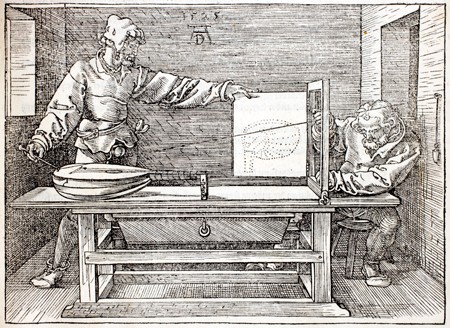In his work on old master drawings, Charles de Tolnay describes drawing as “the vacillation between spirit and matter, artistic illusion and natural object.” And yet the definition of these binaries changed in philosophical and theological discourses thorughout the early modern period, the time of old master drawings. My book “Absence Made Present: An Early Modern History of Drawing and the Senses” examines these interactions between the sensory world of appearances (matter) and the suprasensory, metaphysical domain of self, soul, and God (spirit) in the pedagogy and theory of early modern drawing.
Through draftsmanship, artists learned to use the sensible world of objects and bodies to construct images that activated in the viewer knowledge of metaphysical domains beyond sensory knowledge, from God to the intellect. Nevertheless, the realms of perception and of sensible objects were highly charged in the wake of the Reformation, as the European continent was wracked by wars over the perception of the Eucharist, the presence or absence of God on the altar, and the possibility of attaining knowledge of the divine through material mediation. In looking at drawing through the cross-confessional debates of the early modern period, I seek to disentangle it from mysticism, religion, and romanticism while acknowledging it as a mediator between the sensory and the suprasensory.
In early modern artistic pedagogy, artists first learned to draw from present objects: prints, drawings, sculptures, and bodies. Draftsmen became masters only once they could draw from the intellect with no object or body present. Although recent studies in art history have focused on the “visible” (particularly life drawing, or drawing ad vivum), my book argues that drawing pedagogy did not seek to teach the imitation of present objects. Instead an artist’s virtuosity manifested itself when he worked in the absence of an object, bringing forth histories and images that stimulated in the viewer the sensation of being present before the historical moment, the person, or the still life. Artists studied present objects and bodies to impress “images” into their inner cognitive faculties of memory, imagination, understanding, and intellect. Drawing taught the cultivation of these inner faculties so that artists could draw without the object present. The manifestation of presence remained not only in the sensation of sight but also in the artist’s sense of being before an extended body in all the perceptions of touch, taste, smell, and the sixth sense of sensing, the experience of existence. Moreover, this pedagogy aimed to teach artists to draw that which perhaps had never been present, or whose presence proved elusive, namely, God and the invisible movements of the soul (passions and affects).
My book examines early modern drawing through a study of artists’ treatises, theology, and natural philosophy. To delineate the contours of draftsmanship in early modern pedagogy, my research focuses on drawing manuals, works written by major artists to teach drawing. Famous examples include Albrecht Dürer’s Underweysung der Messung (1525), Luca Ciamberlano’s Scuola perfetta (1610/1620), Crispijn van de Passe’s Licht der teken en schilderkonst (1643), and Abraham Bloemaert’s Artis Apellae liber (1650–1656). I argue that these represent two pedagogical trajectories. Treatises such as Dürer’s Underweyssung der Messung begin with the geometric forms of the point and the line. Other manuals, such as Ciamberlano’s Scuola perfetta, initiate draftsmanship in copying sensory organs (eyes, ears, noses) and include no geometric images. In the trajectory instantiated by Dürer, instruction proceeds from geometric universals to “the particular.” In the pedagogy exemplified by Ciamberlano, knowledge unfolds from the particular world of sensory experience to the universal domain of metaphysical truths. Through examining early modern artistic pedagogy from printed drawing books to theoretical works, my book surveys a period in artistic practice when the physical and the metaphysical were interwoven, from eyes, ears, and noses to Euclidean points and lines. “Absence Made Present” confronts the relationship between knowledge and sensory perception: How do I know not only God but also myself? How can I grasp intellectual truths that remain beyond the sphere of the eyes, ears, and nose?
